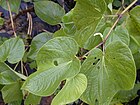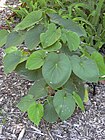Note: This is a project under development. The articles on this wiki are just being initiated and broadly incomplete. You can Help creating new pages.
Difference between revisions of "Piper methysticum - Kava"
(→Parts Used) |
(→Parts Used) |
||
| Line 7: | Line 7: | ||
==Parts Used== | ==Parts Used== | ||
| − | {{Parts Used| | + | {{Parts Used|Roots}}, {{Parts Used|Rhizome}}. |
==Chemical Composition== | ==Chemical Composition== | ||
Revision as of 16:17, 30 May 2018
Kava is a crop of the western Pacific. The roots of the plant are used to produce a drink with sedative, anesthetic, euphoriant, and entheogenic properties. Kava is consumed throughout the Pacific Ocean cultures of Polynesia, including Hawaii, Vanuatu, Melanesia and some parts of Micronesia for its sedating effects. Its active ingredients are called kavalactones. A Cochrane systematic review concluded it was likely to be more effective than placebo at treating short-term anxiety.
Contents
- 1 Uses
- 2 Parts Used
- 3 Chemical Composition
- 4 Common names
- 5 Properties
- 6 Habit
- 7 Identification
- 8 List of Ayurvedic medicine in which the herb is used
- 9 Where to get the saplings
- 10 Mode of Propagation
- 11 How to plant/cultivate
- 12 Commonly seen growing in areas
- 13 Photo Gallery
- 14 References
- 15 External Links
Uses
nausea, loss of appetite, tiredness, liver disorders, abdominal pain, dark urine, anxiety ,stress, Sore throats
Parts Used
Chemical Composition
Trimethyl-1-naphthol, 5-methyl-1-phenylhexen-3-yn-5-ol, octadecadienoic acid-methyl ester, Dimethylflavanone, Pinostrobin chalcone and 7-dimethoxyflavanone-5 hydroxy[1]
Common names
| Language | Common name |
|---|---|
| Kannada | |
| Hindi | |
| Malayalam | |
| Tamil | |
| Telugu | |
| Marathi | NA |
| Gujarathi | NA |
| Punjabi | NA |
| Kashmiri | NA |
| Sanskrit | |
| English | Agrimony |
Properties
Reference: Dravya - Substance, Rasa - Taste, Guna - Qualities, Veerya - Potency, Vipaka - Post-digesion effect, Karma - Pharmacological activity, Prabhava - Therepeutics.
Dravya
Rasa
Tikta (Bitter), Kashaya (Astringent)
Guna
Laghu (Light), Ruksha (Dry), Tikshna (Sharp)
Veerya
Ushna (Hot)
Vipaka
Katu (Pungent)
Karma
Kapha, Vata
Prabhava
Habit
Identification
Leaf
| Kind | Shape | Feature |
|---|---|---|
| Simple | alternate | The leaves are heart-shaped, 10-30 cm x 8-23 cm; stipules large, persistent |
Flower
| Type | Size | Color and composition | Stamen | More information |
|---|---|---|---|---|
| Unisexual | 3-9 cm long | Yellow | 2 | The female spike bears flowers with a single basal ovule in an unilocular ovary topped by a stigma. |
Fruit
| Type | Size | Mass | Appearance | Seeds | More information |
|---|---|---|---|---|---|
| General | 7–10 mm | Fruit seldom produced; a berry containing one seed | single | {{{6}}} |
Other features
List of Ayurvedic medicine in which the herb is used
- Vishatinduka Taila as root juice extract
Where to get the saplings
Mode of Propagation
How to plant/cultivate
The kava plant is propagated from cuttings taken from the lower stems or from the younger stems once separated from the rootstock when the root is harvested.[3]
Commonly seen growing in areas
Damp areas, near streams, Borders of forests and fields.
Photo Gallery
References
External Links
- Ayurvedic Herbs known to be helpful to treat nausea
- Ayurvedic Herbs known to be helpful to treat loss of appetite
- Ayurvedic Herbs known to be helpful to treat tiredness
- Ayurvedic Herbs known to be helpful to treat liver disorders
- Ayurvedic Herbs known to be helpful to treat abdominal pain
- Ayurvedic Herbs known to be helpful to treat dark urine
- Ayurvedic Herbs known to be helpful to treat anxiety
- Ayurvedic Herbs known to be helpful to treat stress
- Ayurvedic Herbs known to be helpful to treat Sore throats
- Herbs with Roots used in medicine
- Herbs with Rhizome used in medicine
- Herbs with common name in English
- Habit - Shrub
- Index of Plants which can be propagated by Seeds
- Index of Plants which can be propagated by Cuttings
- Herbs that are commonly seen in the region of Damp areas
- Herbs that are commonly seen in the region of near streams
- Herbs that are commonly seen in the region of Borders of forests and fields
- Herbs







